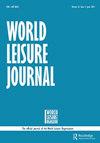休闲的性别差异:来自韩国休闲类型-时间与时间使用满意度的关系
IF 2
Q3 HOSPITALITY, LEISURE, SPORT & TOURISM
引用次数: 0
摘要
摘要本研究旨在通过考察每种休闲类型的时间和时间使用满意度(TUS)之间的关系,找出休闲中的性别差异。根据对韩国时间使用调查的分析,男性的运动/娱乐和休息以及女性的爱好和休闲学习与TUS呈正相关,而对于女性来说,休闲类型越多样化,TUS就越高。我发现,强加给女性的性别规范减少了她们的休闲时间和满意度,与男性相比,女性的劳动力市场参与大大限制了休闲的数量和质量。休闲中的性别差异是由资源可用性来解释的,女性的休闲活动更多地受到时间资源和男性经济资源的影响。休闲曲目或时间与满意度之间的非线性关系在休闲多样性和时间的组合中表现出性别差异,这增加了休闲的积极影响。本文章由计算机程序翻译,如有差异,请以英文原文为准。
Gender differences in leisure: from the relationship between leisure type-time and time use satisfaction in Korea
ABSTRACT This study aims to find out gender differences in leisure by examining the relationship between time and time use satisfaction(TUS) for each leisure type. As a result of analysing the Korean Time Use Survey, sports/leports and rest for men and hobbies and leisure learning for women showed a positive correlation with TUS, and for women, the more diverse the leisure types, the higher the TUS. I found that the gender norms imposed on women reduced their leisure time as well as their satisfaction, and that women’s labour market participation significantly constrained the quantity and quality of leisure compared to men. Gender differences in leisure are explained by resource availability, and women's leisure activities are more influenced by time resources and men’s financial resources. The nonlinear relationship between leisure repertoire or time and satisfaction shows gender differences in the combination of leisure diversity and time that increase the positive influence of leisure.
求助全文
通过发布文献求助,成功后即可免费获取论文全文。
去求助
来源期刊

World Leisure Journal
HOSPITALITY, LEISURE, SPORT & TOURISM-
CiteScore
3.10
自引率
6.20%
发文量
34
期刊介绍:
As the official journal of the World Leisure Organisation, the purpose of the World Leisure Journal is to stimulate and communicate research, theory, and critical thought in all areas that address leisure, including play, recreation, the arts and culture, sport, festivals, events and celebrations, health and fitness, and travel and tourism. Empirical and theoretical manuscripts, as well as position papers, review articles, and critical essays are published in the World Leisure Journal . The World Leisure Journal is international in scope, and encourages submissions from authors from all areas of the world. Comparative cross-national and cross-cultural research reports are especially welcome. For empirical papers, all types of research methods are appropriate and the subject matter in papers may be addressed from perspectives derived from the social, behavioural, and biological sciences, education, and the humanities. Both pure and applied research reports are appropriate for publication in the World Leisure Journal . In addition to original research reports and review essays, book reviews, research notes, comments, and methodological contributions are appropriate for publication in the World Leisure Journal .
 求助内容:
求助内容: 应助结果提醒方式:
应助结果提醒方式:


